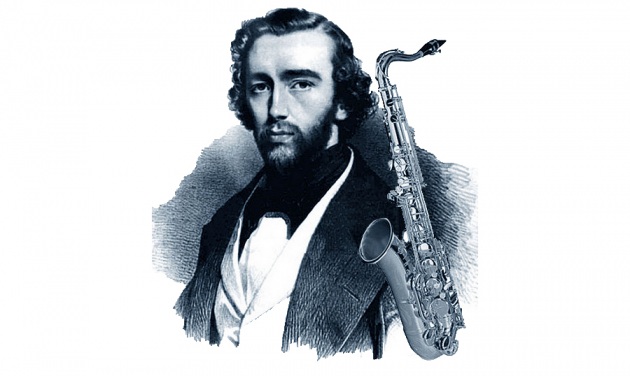The Devil's Horn (1840)
In the film, Some Like It Hot, Marilyn Monroe, in the role of Sugar Kane Kowalczyk, revealed that blondes prefer gentlemen who wield saxophones; in the Clinton administration, the saxophone became the First Instrument; in The Simpsons, Lisa made the saxophone attractive to girls. These scenarios would not have been possible if not for Joseph-Antoine Adolphe Sax.
While the instrument is associated with 1920s New Orleans jazz, its origin was in nineteenth century French-owned Belgium. Adolphe was born in 1814 in the charming town of Dinant on the bank of the Meuse River. His childhood home is now La Maison du Monsieur Sax; in front is a statue of Adolphe on a bench, creation in hand. The town pays tribute to its outstanding son with twelve painted saxophones on the Charles de Gaulle Bridge; tourist brochures bear the slogan, “Sax and the City.” His father, Charles, owned a musical instrument business and enjoyed the patronage of Wilhelm I of Orange.
It is something of a miracle that Adolphe lived to create anything at all. As a child, a brick fell on his head; he swallowed a needle; tumbled down a flight of stairs; suffered burns in an explosion, narrowly escaped drowning, and ingested water contaminated with sulfuric acid. The neighborhood called the accident-prone Adolphe, “little ghost.”
Along with four of his eleven siblings, he worked in his father’s shop. A born musician, he mastered the flute, clarinet, as well as his own creations: the steam organ, the sax tuba, the sax trombone, the bass tuba, and the flugelhorn. In 1877, at the request of Richard Wagner, he designed the Wagner tuba. A prolific inventor, he received his first patent in 1838 for “a new system for the bass, contrabass and the bourden clarinet.” During the span of his career, Adolphe accumulated forty-six additional patents for fine-tuning existing instruments. 
His greatest creation-the saxophone- debuted at the 1841 Belgian National Exhibition. Jealous of the sixteen-year-old, fellow musicians refused to acknowledge his brainchild as it came from that “weedy little pupil, Sax.” A rival kicked his masterpiece across the stage.
The disrespect led to Antoine’s move to Paris where composer Hector Berlioz dubbed the instrument le saxophons, and stated, “It cried, sighs, and dreams.” Due to his patronage, le saxophons became a part of every military band in France, Prussia, Italy, Spain, and Hungary. What dampened Adolphe’s triumph was the Parisians disliked the Belgian upstart who muscled in on their own music-making business. His enemies launched lawsuits, and Adolphe endured blackmail, theft, arson, and an assassination attempt. A cancerous lip tumor almost proved fatal. Facing bankruptcy, he sold his instruments that now reside in the Museum of Musical Instruments in Brussels. Despite creating the saxophone renowned from Paris jazz clubs to New Orleans blues joints, in 1894, Adolphe died destitute in France. His interment was in the Montmartre cemetery.
While Janis Joplin declared she was saving the bass played for Omaha, Sugar Kane’s libido ignited for saxophone players. As she relayed of their sexual spell, “I get goose pimply all over and I come to them. Then one morning, you wake up, the guy’s gone, the saxophone’s gone…” The saxophone left grief in its in its wake for Adolphe and Sugar Kayne, and animosity in others.
In 1903, fearful that the instruments’ profane sound would contaminate sacred music, Pope Pius X denounced it from the Vatican. Hitler issued a ban due its association with American “jungle music.” Believing the sax an instrument of capitalist oppression, Stalin sentenced musicians who played it to Siberia. Due to the saxophone’s bad rap and the association of its curled shape to a coiled serpent, detractors dubbed the saxophone The Devil’s Horn.


